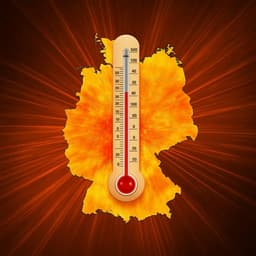
Earth Sciences
Increase in ocean-onto-land droughts and their drivers under anthropogenic climate change
Y. Guan, X. Gu, et al.
Discover how ocean-onto-land droughts (OTLDs) have escalated due to climate change, leading to more frequent and severe impacts worldwide. This research sheds light on the atmospheric changes driving these shifts, conducted by a team of experts including Yansong Guan and Louise J. Slater.
~3 min • Beginner • English
Introduction
Droughts on land have major impacts on water resources, agriculture, ecosystems, and socio-economic systems. A newly identified contributor to terrestrial droughts is precipitation-minus-evaporation (PME) deficits that originate over the ocean and migrate onto land, termed ocean-onto-land droughts (OTLDs). Prior work has shown that such oceanic PME deficits can reduce terrestrial water storage by diminishing moisture transport and that OTLDs are generally larger, more intense, and develop and intensify faster than land-only droughts. Despite growing evidence that anthropogenic climate change affects drought frequency, duration, intensity, and spatial extent, it is unknown whether a detectable anthropogenic signal exists in OTLDs and how human-induced warming influences the physical mechanisms driving OTLD-related moisture transport. This study identifies global OTLDs in reanalysis and CMIP6 simulations to assess historical and future changes, attributes these changes to anthropogenic forcings, and investigates the dynamic and thermodynamic drivers of OTLD-linked moisture transport.
Literature Review
Methodology
Data and experiments: The study uses CMIP6 simulations for historical all-forcings (ALL; 1960–2014) merged with future high-emissions ScenarioMIP SSP585 (2015–2100) to form 1961–2100 time series for each model. Detection and Attribution MIP (DAMIP) experiments include hist-nat (NAT), hist-GHG (GHG), and hist-aer (AER) to separate forcing contributions. Projections under SSP370 are also analyzed to test robustness. Ten CMIP6 GCMs providing monthly variables were selected: precipitation (pr), evaporation (evspsbl), near-surface air temperature (tas), specific humidity (hus; 19 levels), surface pressure (ps), and winds (ua, va; 19 levels). The first ensemble member (r1i1p1f1) was used and outputs were bilinearly interpolated to 1°×1°. ERA5 reanalysis provided historical precipitation and evaporation for evaluation and bias correction.
Bias correction: Quantile Delta Mapping (QDM) was applied to adjust the CDFs of ALL simulations to ERA5, reducing systematic biases in precipitation and evaporation. The derived bias adjustments from ALL were transferred to NAT, AER, GHG, and SSP585/SSP370 for each model under the assumption of shared model-specific biases across forcings.
OTLD identification: PME anomalies (PMEA) were computed using 12-month accumulated precipitation minus evaporation. A non-parametric standardized precipitation–evapotranspiration index (SPMEI) was derived from PMEA via kernel density estimation. A median filter was applied to SPMEI fields, and a drought threshold of 0.2 was used to detect drought cells. A spatiotemporal clustering algorithm tracked spatiotemporally contiguous drought clusters (STCDCs): (i) spatially contiguous drought clusters (SCDCs) had minimum area ≥10,000 km²; (ii) SCDCs overlapping across consecutive months were merged into STCDCs. OTLDs were defined as STCDCs that originated entirely over the ocean and subsequently spread onto land covering at least 100,000 km². Post-landfall periods were used to characterize events. For some analyses, 1,000 highest-magnitude OTLDs (100 per model; top ~22%±2%) were selected based on total magnitude.
OTLD characteristics: Extracted metrics included (1) post-landfall duration (months), (2) maximum land area (km²), (3) intensity (sum of PMEA over land, mm), and (4) total magnitude (mm-months). Spatial patterns and distributions were evaluated against ERA5. A Relative Anthropogenic Index (RAI) quantified the anthropogenic signal by comparing ALL with NAT (and with GHG/AER where relevant), with uncertainties assessed via bootstrapping to produce 90% confidence intervals.
Moisture transport analysis: Vertically integrated moisture divergence (proxy for PME) and water vapor flux (integrated vapor transport) anomalies were computed relative to climatology to diagnose moisture pathways during pre- and post-landfall OTLD phases across six hotspots: western North America (WNA), southern South America (SSA), Europe and northern Africa (EA), southern Africa (SAF), eastern Asia (EAS), and Australia (AU). Changes between SSP585 and ALL were analyzed. The integrated moisture divergence (PME) changes were decomposed into thermodynamic vs dynamic components, further split into advection and convergence terms and a nonlinear residual, to quantify contributions of physical drivers during post-landfall periods.
Risk assessment: Self-organizing maps (SOM) with unsupervised learning classified regions into four risk levels (I–IV) using OTLD characteristics under ALL (1981–2010) and SSP585 (2071–2100).
Key Findings
- Historical identification and model evaluation: 4,516 OTLDs were identified globally (1961–2020; 10 CMIP6 models, ALL). Mean duration was 10.47 ± 0.49 months; mean maximum area 1.65 ± 0.33 × 10^6 km²; mean intensity 1.55 ± 0.38 × 10^5 mm. Bias-corrected CMIP6 multi-model ensemble reproduced spatial patterns of OTLD characteristics relative to ERA5 (spatial correlations r ≈ 0.65–0.69; relative errors 0.10–0.18; p < 0.001). Over individual models, 58% of combinations showed r > 0.5 (p < 0.001).
- Anthropogenic influence in the historical period: Probability distributions of duration, maximum area, intensity, and total magnitude in ALL are significantly shifted rightward relative to NAT, indicating anthropogenic enhancement. Positive anomalies (ALL − NAT, normalized by ALL) in frequency, duration, areal extent, intensity, and total magnitude occur over 70.63%, 64.90%, 67.46%, 73.95%, and 69.52% of land, respectively. The Relative Anthropogenic Index (RAI) medians and 90% CIs are above zero globally for all characteristics, with detectability in 19 of 30 hotspot-characteristic combinations (63%). Regional aerosol effects produce historical weakening over EA, while GHGs enhance OTLDs; dominance of GHGs is expected to shift EA from weakening to enhancement as aerosols decline.
- Future projections (SSP585): Landfalling OTLD frequency increases by 63.13–223.82% across the six hotspots (2021–2100 vs 1961–2020). Globally, OTLDs become more frequent (+39.68%), persistent (+54.25%), widespread (+448.92%), and severe (+612.78%). Significant upward trends (p < 0.0001) occur by century’s end: duration +0.8 months/decade; intensity +9.0 × 10^4 mm/decade; maximum area +3.9 × 10^5 km²/decade; total magnitude +1.0 × 10^7 mm-months/decade. Under 3°C warming, increases are +48.15% (frequency), +63.94% (duration), +401.52% (areal extent), and +499.71% (severity). Results are consistent under SSP370.
- Moisture transport mechanisms: OTLD intensification is associated with reduced ocean-to-land moisture transport. In the Northern Hemisphere (WNA, EA, EAS), strengthened subtropical anticyclones cause landward migration of moisture divergence and deficits, enhancing OTLDs; under SSP585, anticyclone-related water vapor flux anomalies strengthen by roughly an order of magnitude. In the Southern Hemisphere (SSA, SAF, AU), circulation is more complex with multiple pathways (e.g., anticyclones and cyclones over the southern oceans) and topographic blocking (Andes) modulating inland propagation.
- Physical drivers decomposition: Thermodynamic processes dominate OTLD enhancement, contributing 30–55% of integrated moisture divergence (PME) changes across hotspots, primarily via the advection thermodynamic component (54–97% of the thermodynamic contribution). Anthropogenic warming induces circulation slowdown and a stronger land–ocean warming contrast, weakening ocean-to-land moisture transport and intensifying landward PME deficits, especially in the tropics and subtropics.
- Risk assessment: High-risk OTLD areas increase from 15% of land (historical ALL) to 51.2% (future SSP585). The six hotspots exhibit the largest expansion, with 37–100% of their land areas reaching high-risk levels. Approximately 50.9% of the global population (projected for 2071–2100) is expected to face the highest OTLD risk under SSP585.
Discussion
The study addresses whether anthropogenic climate change has detectably intensified ocean-onto-land droughts and elucidates the mechanisms. By combining ERA5 with bias-corrected CMIP6 ensembles and formal detection–attribution across ALL vs NAT (and GHG vs AER), the authors demonstrate that human influence has already increased OTLD frequency, duration, extent, and severity over most land areas. The relative anthropogenic index confirms a detectable signal globally and across most hotspot-region characteristics. Mechanistically, intensified subtropical anticyclones in the Northern Hemisphere and complex circulation changes in the Southern Hemisphere reduce ocean-to-land moisture transport during OTLDs. Thermodynamic responses to warming—especially enhanced specific humidity changes and land–sea thermal contrast—dominate the reduction of moisture transport, with dynamic circulation shifts (e.g., Hadley and Walker changes) modulating regional pathways. Aerosols dampened historical OTLDs in Europe–North Africa, but decreasing aerosol emissions and increasing GHGs are projected to reverse this effect, leading to stronger future OTLDs. The findings imply substantial increases in OTLD-related risks for populations and ecosystems, emphasizing the relevance of mitigation and adaptation strategies and improved forecasting of moisture-transport-driven drought propagation.
Conclusion
The study provides robust evidence that anthropogenic emissions have intensified ocean-onto-land droughts historically and will amplify them further under high-emissions futures. Using PME-based identification and comprehensive CMIP6 attribution, the authors show widespread increases in OTLD frequency, persistence, extent, and severity, driven primarily by thermodynamic weakening of ocean-to-land moisture transport and strengthened subtropical anticyclones. Risk mapping indicates a large expansion of high-risk areas, affecting roughly half of the projected global population by late century, with the most pronounced impacts in western North America, southern South America, Europe–North Africa, southern Africa, eastern Asia, and Australia. These results highlight the need to incorporate OTLD processes into drought monitoring and early warning, and to implement mitigation and adaptation measures to reduce future risks. Future work should further resolve the roles of internal variability and teleconnections in OTLD evolution and impacts.
Limitations
The authors note that the influence of internal climate variability on OTLDs remains unclear. Interactions with modes such as ENSO and the Indian Ocean Dipole may affect moisture transport and OTLD behavior, particularly in regions like northeastern Australia. The study focuses on spatially direct and temporally continuous oceanic moisture deficit impacts; teleconnection pathways from marine or land sources that might synchronize or lag terrestrial droughts are not fully assessed. While bias correction and multi-model ensembles are used, uncertainties inherent in models, forcings (e.g., aerosols), and circulation responses persist and may affect regional projections.
Related Publications
Explore these studies to deepen your understanding of the subject.







